Abstract
Urban blue–green space (UBGS) plays a critical role in mitigating the urban heat island (UHI) effect and reducing land surface temperatures (LSTs). However, existing research has not sufficiently explored the optimization of UBGS spatial configurations or their interactions with urban morphology. This study takes New York City as a case and systematically investigates small-scale urban cooling strategies by integrating multiple factors, including adjustments to the blue–green ratio, spatial layouts, vegetation composition, building density, building height, and layout typologies. We utilize multi-source geographic data, including LiDAR derived land cover, OpenStreetMap data, and building footprint data, together with LST data retrieved from Landsat imagery, to develop a prediction model based on generative adversarial networks (GANs). This model can rapidly generate visual LST predictions under various configuration scenarios. This study employs a combination of qualitative and quantitative metrics to evaluate the performance of different model stages, selecting the most accurate model as the final experimental framework. Furthermore, the experimental design strictly controls the study area and pixel allocation, combining manual and automated methods to ensure the comparability of different ratio configurations. The main findings indicate that a blue–green ratio of 3:7 maximizes cooling efficiency; a shrub-to-tree coverage ratio of 2:8 performs best, with tree-dominated configurations outperforming shrub-dominated ones; concentrated linear layouts achieve up to a 10.01% cooling effect; and taller buildings exhibit significantly stronger UBGS cooling performance, with super-tall areas achieving cooling effects approximately 31 percentage points higher than low-rise areas. Courtyard layouts enhance airflow and synergistic cooling effects, whereas compact designs limit the cooling potential of UBGS. This study proposes an innovative application of GANs to address a key research gap in the quantitative optimization of UBGS configurations and provides a methodological reference for sustainable microclimate planning at the neighborhood scale.
1. Introduction
1.1. Research Background
1.1.1. Urban Heat Island and Health
The urban heat island (UHI) effect refers to the phenomenon in which urban areas exhibit significantly higher air and surface temperatures compared to surrounding rural areas [1,2]. Its physical mechanism can be attributed to anthropogenically induced energy imbalances in urban surface-atmosphere systems [3,4]: the expansion of impervious surfaces enhances solar radiation absorption [5,6], while the reduction in vegetation diminishes latent heat flux [7]. These factors, combined with anthropogenic heat emissions from air conditioning systems and transportation [8] (accounting for 30% of urban energy budgets), collectively reconfigure the thermodynamic processes within the urban boundary layer.
From the public health perspective, the UHI effect significantly increases the incidence rates and mortality of heat-related illnesses through synergy with global climate change [9,10]. Epidemiological studies indicate that excess mortality rates in urban cores during heatwaves can be twice as high as those observed in suburban areas [11,12,13], with particular vulnerability among elderly populations and individuals with cardiopulmonary diseases [14,15]. In environmental economics, the UHI drives an annual 19% growth rate in cooling energy consumption [16,17] while exacerbating ozone and PM2.5 pollution [18,19,20], thereby establishing a vicious cycle of “high temperature, high energy demand, and high pollution.” According to the United Nations’ World Urbanization Prospects, global urbanization rates are projected to reach 68% by 2050 [21,22,23], with built-up areas occupying only 3% of the Earth’s land surface area. This intensified spatial concentration of urban populations will substantially amplify both the intensity and spatial extent of UHI impacts [24,25]. In this context, developing effective UHI mitigation strategies is crucial for improving urban ecological environments, addressing climate change, and enhancing the quality of life for urban residents.
1.1.2. Urban Blue–Green Space
Urban blue–green spaces (UBGS) refer to integrated spatial systems comprising water bodies and vegetated areas within cities [26,27,28]. The term “blue” typically refers to all visible surface waters, such as rivers, lakes, and coastal waters [29,30]; “green” includes parks, sports fields, forests, backyard gardens, and farmland, vegetated open spaces, protected areas, and other vegetation-dominated spaces [31,32].
UBGS possess multidimensional cooling mechanisms: rivers and lakes play a crucial role in cooling through evaporation, known as the river cooling effect [33,34,35]; vegetation primarily cools the surrounding environment through shading and evapotranspiration [36,37]. Currently, UBGS are recognized as one of the most important land-use categories for mitigating the UHI effect [38,39,40]. As a nature-based solution, urban blue-green spaces offer unique advantages over strategies such as using new building materials [41,42,43], optimizing building density and ventilation corridors [44,45], and designing district cooling systems [46,47]—they are cost-effective, environmentally friendly, and politically acceptable. Therefore, many regions have incorporated UBGS into their climate adaptation and resilience strategies. For instance, Los Angeles, New York, Chicago, Denver, and Austin have implemented Million Tree Initiatives to mitigate UHI effects [48]; Seoul’s Cheonggyecheon Stream restoration project reduces local temperatures by 3.3–5.9 °C (mean: 4.6 °C) [49]; and Melbourne plans to increase its tree canopy cover to 40% by 2040 to alleviate UHI impacts [50].
1.1.3. Urban Land Surface Temperatures
A critical indicator of urban thermal environments is land surface temperature (LST), defined as the Earth’s surface temperature measured via thermal radiation. Most studies investigating the impact of urban configurations on UHI effects identify a relatively strong correlation between UHI intensity and LST [51,52,53]. Research shows that the area [54], configuration [55], layout [56], shape [57], spatial structure, and synergistic effects of green spaces and water bodies [28,58] significantly influence LST reduction.
Specifically, larger contiguous green spaces exhibit more pronounced cooling ranges and intensities [59]. For example, when blue–green spaces reach 2.98 ha and 4.84 ha, their cooling effectiveness significantly increases [60]. Meanwhile, optimized layouts of smaller green spaces can substantially enhance local cooling effects [61]. Additionally, the geometric complexity of green and blue infrastructure plays a crucial role in thermal regulation: water bodies with more complex boundaries demonstrate stronger cooling effects, while wedge-shaped green spaces significantly improve thermal comfort at urban edges [62]. Furthermore, green space connectivity and water body width enhance cooling intensity [63].
1.1.4. Building Morphology and LST
Existing research shows that building height [64,65], density [66,67,68], and layout [51,69] significantly impact the UHI effect. In terms of height, increasing height typically raises the local LST and intensifies urban heat. For example, a simulation study in Tehran reported that the average daily temperature difference between current and planned scenarios could reach 1.38 °C [64]. Notably, in Chinese megacities like Beijing and Shanghai, a logarithmic negative relationship was found, where height increases below 66 m provide cooling, but the effect diminishes beyond this threshold [65].
With respect to density, studies have indicated that building density contributes more significantly to the UHI effect compared to height, particularly in low-rise, high-density areas [66]. Research in Zhengzhou has revealed a nonlinear relationship between building density, height, and LST, with critical thresholds at which trends reverse, underscoring the need for context-specific and refined urban strategies [70].
At the layout level, experimental evidence at the block scale suggests that under fixed coverage ratios and height constraints, chessboard or mixed block layouts can effectively reduce LST [51]. In addition, studies have shown that the average LST of urban blocks and UGSs is positively correlated with building density [71,72]. Overall, building form interacts closely with blue–green spaces [73,74], underscoring the importance of understanding these relationships for effective urban cooling strategies.
1.2. Research Motivation
Existing studies have extensively demonstrated the significant role of BGSs in mitigating UHI effects and reducing the LST. However, most research has focused on the correlation between landscape characteristics and thermal variation, primarily investigating how factors such as area, shape, and patch density influence cooling intensity and spatial extent [61]. With increasing constraints on urban land use, the expansion of BGS has become limited [75]. Yet, the critical concept of a “cooling threshold” for BGS remains underexplored, hindering their effective application in UHI mitigation and climate adaptation strategies [76]. Furthermore, current research tends to concentrate on the cooling effects of large-scale green spaces or water bodies [1,33,77,78,79], while effective scientific methods for optimizing the proportion, spatial configuration, and plant composition of BGSs at the microscale remain lacking. Although a few studies have addressed the cooling performance of small-scale waterfront communities or urban parks [80,81,82,83], their findings are often difficult to directly translate into practical planning at the neighborhood level. This research gap significantly constrains the technological transformation of BGS-related cooling benefits in refined urban governance, highlighting the urgent need to establish a theoretical framework for microscale thermal environment regulation.
Current research primarily relies on three technical approaches: (1) Regression models (e.g., linear regression; geographically weighted regression (GWR)) [71,81,84], which rely on linear assumptions and fail to capture the complex nonlinear relationships between UBGSs and LST. (2) Microclimate simulations (e.g., ENVI-met) [82], which, although capable of simulating current scenarios, typically depend on known meteorological data and lack the capacity to predict future conditions. (3) Machine learning algorithms (e.g., Random Forest (RF); Extreme Gradient Boosting (XGBoost)) [83], which rely on structured numerical inputs and struggle to directly process the spatial features of blue–green spaces, such as form, layout, and adjacency, thus limiting the accurate modeling of LST dynamics.
These limitations arise not only from application scenarios but also from the inherent methodological nature of these approaches: they rely on structured, vector-based analytical frameworks that struggle to capture the complex spatial characteristics embedded in design tasks. Yet, in practical urban design, blue–green space configurations are typically represented through visual plans or drawings. Bypassing the intermediate step of feature extraction and directly predicting thermal responses from these visual inputs would better meet the demand for efficient and design-integrated workflows.
1.3. Research Objective
Investigating Optimization Strategies for UBGS Configuration in Small-Scale Urban Neighborhoods: We design five simulation scenarios under controlled conditions to investigate optimization strategies for UBGS configurations in small-scale urban neighborhoods. Building on established water–vegetation synergy mechanisms [28,58], we first introduce land resource constraints by altering blue–green combinations within fixed areas (e.g., full water and full vegetation configurations) to observe trends in land surface temperature changes. With the total blue–green area and ratio held constant [54], we then examine the local cooling impacts of five typical layouts: Clustered–Point, Dispersed–Linear, Concentrated–Linear, Dispersed–Random, and Hybrid configurations [56,61]. Leveraging vegetation composition effects [36,37], we analyze how adjusting tree-to-shrub proportions influences cooling while maintaining a constant blue–green area, ratio, and layout. Subsequently, we apply optimal blue–green configurations [62] to different neighborhood types [44,45] to evaluate temperature regulation effects under varying building densities, heights, layouts, and mixed height–density conditions. Finally, addressing small-scale efficiency constraints [57,60], we simulate spatial concentration levels using pixel clusters to explore strategies for achieving optimal cooling with minimal blue–green coverage.
Developing a GAN-Based UBGS Prediction Model: The relationship between UBGS and the LST is characterized by significant nonlinearity and spatial heterogeneity. Modeling this relationship poses challenges due to structural complexity and strong variable interactions. To address these issues, this study adopts a GAN as the primary modeling approach. The GAN is capable of directly processing UBGS imagery, effectively capturing spatial distribution, morphology, and adjacency relationships. It has demonstrated strong performance in image generation and prediction tasks [85,86,87]. By learning complex input–output mappings, the GAN can generate high-resolution predictive images, making it well suited for scenario simulation and comparative analysis in urban contexts.
In contrast, convolutional neural networks (CNNs) and recurrent neural networks (RNNs) are primarily applied to image classification and sequential modeling tasks [51,88,89,90] and are not designed for spatial image-to-image generation. Existing studies have shown that the GAN outperforms CNNs and RNNs in terms of prediction accuracy, visual quality, and computational efficiency, particularly in high-resolution image generation tasks [85,86] and has been widely applied in urban planning simulations [91,92]. Although this study does not conduct direct comparative experiments with CNNs or RNNs, extensive theoretical and empirical evidence supports the selection of the GAN as a suitable modeling framework. Therefore, we consider the use of a GAN to be well grounded in both theory and methodological alignment.
1.4. Research Contribution
The research contributions include the following: (1) Investigation of optimization strategies for urban UBGS configurations in small-scale neighborhoods, with a specific focus on quantifying UBGS cooling effectiveness thresholds to address critical gaps in existing research. (2) Development of a fine-grained predictive model for UBGS configurations using GAN technology, which enables the generation of high-resolution images reflecting LST variations under different UBGS configurations. This supports optimal decision-making in urban planning. (3) Quantitative analyses reveal that a 3:7 UBGS ratio, Concentrated–Linear distribution patterns, and a 2:8 shrub-to-tree ratio significantly reduce the LST in high-density urban areas, providing specific guidelines for urban design.
2. Materials and Methods
2.1. Research Framework
This study aims to elucidate the relationship between UBGS configurations and LST in complex urban environments. A GAN-based prediction model is developed through three stages, as illustrated in Figure 1.
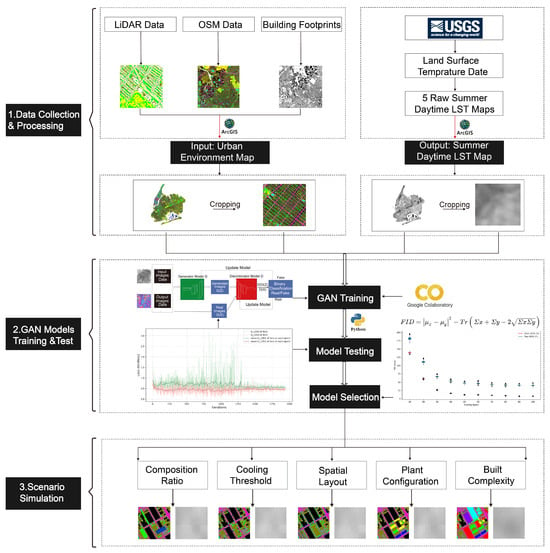
Figure 1.
Research framework.
In Stage 1 (Data Processing), high-resolution urban environment maps are constructed using New York City’s (NYC) LiDAR land cover data (with 98% accuracy and eight land-use categories), OpenStreetMap (OSM) vector data, and building footprint layers. Meanwhile, daytime LST maps (30 m resolution) from USGSs are processed using spatiotemporal interpolation and data fusion methods to obtain summer 2024 average values. Input–output image pairs are then generated for model training.
In Stage 2 (Model Training), the paired datasets are fed into a GAN framework (pix2pixHD) to learn the nonlinear relationship between urban morphology and thermal environments. The model is trained and optimized on Google Colab using the Fréchet Inception Distance (FID) as the evaluation metric, with the final model selected based on the lowest FID score.
In Stage 3 (Scenario Simulation), planning parameters are varied, including UBGS coverage ratios, tree-to-shrub ratios, pixel cluster sizes, spatial layouts, and built complexity. The trained model is then used to generate summer LST prediction maps under each configuration, providing visual and quantitative feedback on the thermal impacts of design interventions and supporting more informed decision-making in urban planning.
2.2. Data Collection and Processing
2.2.1. Urban Environment Input Map
Urban environment input maps (see Figure 2) are constructed by integrating LiDAR data from the NYC Open Data platform [93], OSM data [94], and NYC building footprint data [95]. These maps serve as high-resolution representations of spatial structures for subsequent thermal modeling.
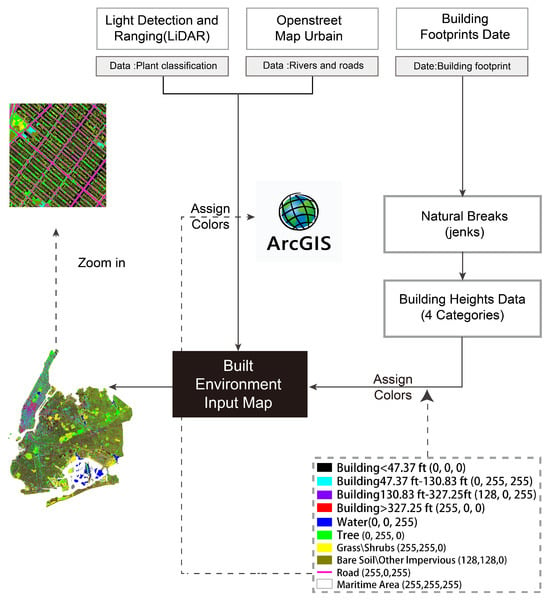
Figure 2.
Urban environmental dataset processing workflow.
The 2017 LiDAR-derived land cover dataset, with 6-inch spatial resolution and 3D attributes, includes eight surface types such as tree canopy, grass/shrubs, buildings, and roads, and is used to extract vegetation layers with accurate vertical differentiation. A top-down overlay method places impervious surfaces at the bottom, roads in the middle, and vegetation on top to ensure correct spatial representation in overlapping areas.
The 2024 OSM dataset provides vector-based boundaries for key urban features, including roads, buildings, waterbodies, vegetation, and impervious surfaces. Since this study focuses primarily on inland water features such as rivers and lakes, these are marked in blue, while oceanic areas are displayed in white to avoid confusion.
The NYC Building Footprints database is used to extract the geometric shapes and attribute information of buildings, including the Building Identification Number (BIN), Borough-Block-Lot (BBL), ground elevation, roof height (HEIGHT_ROOF), construction year, and building type. Following previous research [51], building heights are classified using the Jenks natural breaks method into four categories: low-rise (<47.37 ft), mid-rise (47.37–130.83 ft), high-rise (130.83–327.25 ft), and super high-rise (>327.25 ft).
It should be noted that this classification approach carries certain uncertainties. On one hand, the inherent discontinuities in the Jenks method may lead to misclassification of buildings that are close to classification thresholds. On the other hand, some height attributes in the raw data, such as HEIGHT_ROOF, may be missing or contain anomalous values such as zero. Nevertheless, these issues are unlikely to substantially affect the experimental outcomes. The aim of this study is not to construct a highly precise or regulation-oriented classification model but to employ an AI-driven approach to translate built environment maps that include multi-dimensional spatial variables such as building layout and height into LST images [51].
This enables rapid and visualized prediction of surface thermal patterns under different urban spatial configuration scenarios. Meanwhile, the employed GAN framework exhibits strong feature learning and local context awareness capabilities, which help buffer minor input inaccuracies and ensure the robustness and stability of the prediction results.
Since the LiDAR data were collected in 2017, the time lag may affect the accuracy of green space information. To reduce the potential errors caused by this issue, the study incorporates the latest Landsat [96] multispectral imagery (red, near-infrared, and green bands), applies a maximum likelihood classifier (MLC) for fine-grained vegetation classification, and further conducts manual verification using OSM and Google Maps to enhance the timeliness and reliability of the green space data.
To optimize the image processing performance of the GAN model, the LiDAR and building data are encoded as 8-bit RGB images. A channel-weight maximization strategy is employed to enhance the representation of spectral features and provide clearer semantic cues, thereby significantly improving the model’s ability to extract multi-scale surface information.
2.2.2. Urban LST Output Map
To generate LST output maps for the study area, the research utilizes the Landsat Collection 2 Science Products Surface Temperature dataset from the USGS. This dataset undergoes rigorous processing to ensure high consistency and scientific validity, enabling direct application in landscape change monitoring. With a spatial resolution of 30 m (WGS84 coordinate system) and temperature units in Kelvin (K), LST data for May to September 2024 are downloaded from USGS Earth Explorer under the following quality control protocols:
Data Screening: Only LST images with cloud cover, cloud shadows, and snow/ice coverage below 1% are selected to minimize low-quality data interference.
Missing Data Imputation: June 2024: Replaced with the mean LST values from May and July 2024 due to excessive cloud cover; August 2024: Substituted with August 2023 LST data for the same reason.
In ArcGIS, the Raster Calculator tool is used to calculate pixel-level averages across the five-month LST dataset (including imputed results), thereby generating a summer average temperature distribution map. We chose to use the summer average LST because summer is typically the period when the UHI effect is most pronounced, and the average temperature provides a robust and representative seasonal thermal indicator. We also acknowledge that summer temperatures may be influenced by precipitation and other climatic factors. Considering that precipitation is generally sporadic and short-term, we effectively reduced the impact of such climate variability on the analysis results by using multi-month, cloud-free, and cross-year imputed data. Therefore, these factors have a minimal effect on the overall research outcomes. Subsequently, the LST image is clipped using a NYC administrative boundary shapefile to retain only valid data within the study area (Manhattan, Brooklyn, and Queens).
This clipping process enhances spatial focus by excluding non-study areas. In the LST grayscale map, the grayscale values range from 0 (black, low temperature) to 255 (white, high temperature), and a decrease in the average grayscale value corresponds to a decrease in temperature. Lower grayscale values (close to 0, black) indicate lower temperatures, while higher grayscale values (close to 255, white) indicate higher temperatures. By constraining the analysis to the target region and averaging multiple maps, this study effectively mitigates single extreme values’ impacts on overall results, thereby improving accuracy and reliability.The final result is shown in Figure 3.
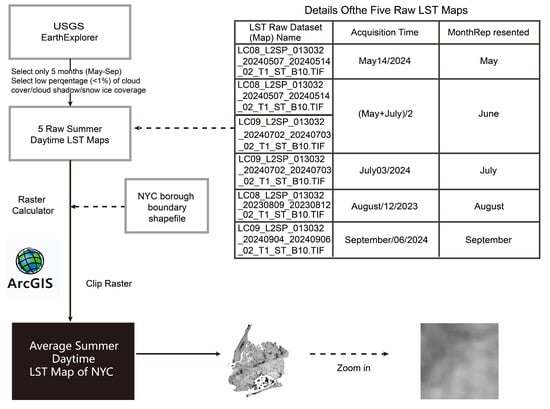
Figure 3.
Processing of LST datasets.
2.2.3. Input–Output Image Processing
To construct high-quality training data required for the GAN model, this study performs projection transformation, alignment, and slicing of urban built environment input maps and LST images to generate standardized training samples.
First, the LST images are reprojected from the WGS84 coordinate system to EPSG:2263 and aligned at the pixel level with the input maps. All images are then exported as high-resolution raster files at 2000 dpi.
Next, the aligned images are divided into 512 × 512-pixel tiles (approximately 1280 × 1280 m) using a custom Pillow [97] script. Invalid tiles are manually removed through visual inspection, resulting in 2,164 valid image pairs, which are split into training and testing sets at a 9:1 ratio. The samples are distributed across Manhattan, Brooklyn, and Queens to ensure geographic representativeness and reduce training bias.
Although the stratified sampling approach used during sample generation may introduce regional imbalance in LST characteristics, previous studies [51,92,98] demonstrate its effectiveness and consistency with the design goals of this research. Table 1 summarizes the detailed process of data collection, processing, and segmentation, while Figure 4 displays a visual comparison and correspondence between the built environment input maps and the LST output maps.

Table 1.
Overview of data collection and processing details.
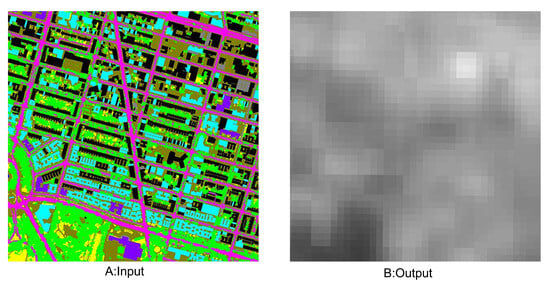
Figure 4.
(A): Input—urban map; (B): Output—LST map.
Overall, a combination of manual refinement and automated preprocessing is employed to control sample distribution and manage outliers, thereby improving data quality and model robustness while maintaining broad geographic coverage.
2.3. GAN Architecture
2.3.1. GAN Architecture and Principles
GANs constitute a deep learning-based adversarial framework. Their core architecture consists of two neural networks: the generator (G) and the discriminator (D), which undergo co-evolution through non-cooperative interaction (see Figure 5). The generator takes random noise vectors or multimodal conditional information (e.g., urban environmental semantic maps) as input and synthesizes data samples that mimic the statistical properties of real data. The discriminator aims to distinguish between real and generated samples, thereby serving as a binary classifier that evaluates sample authenticity.
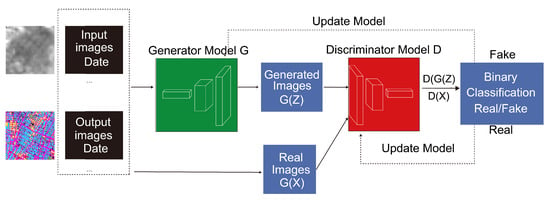
Figure 5.
The basic principles of GAN.
This adversarial setup is typically formulated as a minimax optimization problem, where training dynamics can be interpreted through the lens of a zero-sum game. An equilibrium is achieved when the generator produces outputs that the discriminator classifies as real with 50% probability.
During training, the generator and discriminator are updated alternately via gradient descent. The generator seeks to minimize the probability that its outputs are identified as fake, while the discriminator aims to maximize its classification accuracy. The respective loss functions are given as follows:
where and represent the generator and discriminator losses, respectively; x denotes a real sample, z is a random noise vector, is the generated sample, and outputs the probability that its input is real.
These losses define a competitive training dynamic that improves the generator’s ability to produce realistic outputs while sharpening the discriminator’s detection skills. Through iterative optimization, the distribution of generated samples gradually approximates that of the real data.
2.3.2. Pix2PixHD Architecture and Parameter Configuration
To meet the specific requirements of this study, Pix2PixHD is selected as the core model. As a conditional GAN (CGAN) architecture, Pix2PixHD generates high-resolution output images conditioned on input data by incorporating urban environment maps as conditional features. During implementation, key parameters of Pix2PixHD are adjusted as follows:
Instance Segmentation Mapping Module: Given that the input data adopts an RGB format, the instance segmentation mapping module is disabled (label_nc = 0) to match the data characteristics and reduce computational complexity.
Learning Rate Strategy: A two-phase learning rate strategy is adopted. In the initial phase, a fixed learning rate is maintained to ensure comprehensive learning of input–output mapping relationships. In the second phase, the learning rate gradually decayed via a “learning rate decay” mechanism. This minimized parameter oscillations near optimal solutions, optimizing the model’s final convergence performance.
Beyond these basic parameter adjustments, additional mechanisms were integrated to further enhance training stability and model performance, as summarized in Table 2. Specifically, the model uses multi-scale discriminators, which simultaneously evaluate the generated outputs at different image resolutions, allowing the discriminator to capture both global and local structures. The generator adopts a global generator and local enhancer architecture, combining residual blocks and an encoder–decoder structure to progressively refine the outputs and ensure high-resolution predictions. This design improves adversarial training and enhances the diversity of the generated results. Furthermore, the feature matching loss, controlled by the parameter Lambda Feat (set to 10), encourages the generator to produce outputs with feature statistics similar to real images, thereby stabilizing training. Instance normalization (Norm = Instance) was applied instead of batch normalization to improve stability, especially with small batch sizes. In addition, the model leveraged least-squares GAN loss (No LsGAN = FALSE) to improve gradient behavior and convergence and retained the VGG perceptual loss (No vgg_loss = FALSE) to enhance the perceptual quality of the generated outputs. Collectively, these design choices improve the robustness of the training process and help prevent mode collapse.

Table 2.
Final parameters of the Pix2pixHD GAN model.
2.3.3. Optimization Strategies and Training Protocol
To enhance the model’s generalizability and engineering applicability, this study employed data augmentation based on spatial geometric transformations, including random rotation, flipping, and scaling. These techniques effectively expanded the diversity of the training dataset, significantly improving the model’s adaptability to unstructured inputs. During the optimization iterations, we established a dynamic evaluation mechanism to continuously monitor the generator and discriminator loss functions, allowing for early termination of training when loss convergence was detected. This strategy not only reduced the risk of overfitting but also helped ensure coordinated convergence between the generator and discriminator. The overall optimization scheme was designed to enable the model to better capture the complex nonlinear mapping relationships between blue–green space configurations and surface thermal radiation.
It should be noted that the primary objective of this study was not to develop an optimal model surpassing current technical benchmarks, but rather to validate the feasibility of GAN in complex urban environmental prediction. Therefore, comprehensive model tuning or cross-validation procedures based on different training data partitions were not conducted. After defining the essential parameters, the neural network training was directly initiated. Most model parameters were retained from the default Pix2PixHD configuration, with necessary adjustments made to accommodate the specific characteristics of the dataset (detailed parameters are provided in Table 2).
2.4. Neural Network Training
2.4.1. The Loss Dynamics and Optimization Strategies of the Generator and Discriminator
The loss dynamics and optimization strategies of the generator (G) and discriminator (D) show characteristic dynamic fluctuations during training, as depicted in Figure 6. These dynamics stem from the adversarial mechanism of GAN: the generator gradually approximates real data distributions by producing synthetic samples, while the discriminator endeavors to maximize its capability to differentiate between real and generated data. Specifically, the generator optimizes its parameters to reduce the probability of generated samples being labeled as “fake”, whereas the discriminator aims to enhance its classification accuracy for real data and minimize false acceptance of generated samples.
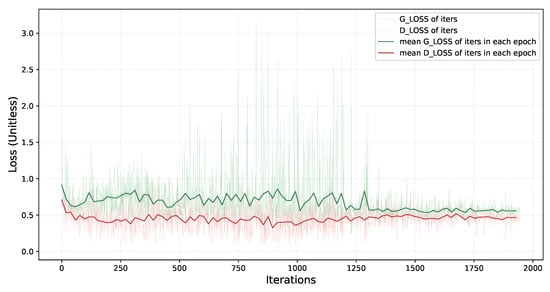
Figure 6.
Loss values of the generator and the discriminator images.
In the initial training phases (e.g., epoch 5), notable loss volatility and poor image quality occur due to the generator’s limited feature learning. As training advances, loss values stabilize, reflecting a gradual convergence toward a dynamic equilibrium between G and D. This equilibrium signifies the improved quality of generated data and more balanced detection capability of the discriminator.
2.4.2. Generated Image Characteristics and Training Termination
Beyond analyzing numerical changes in loss functions, this study documents images generated at various training stages and dynamically evaluated model performance via visualizations (Figure 7).
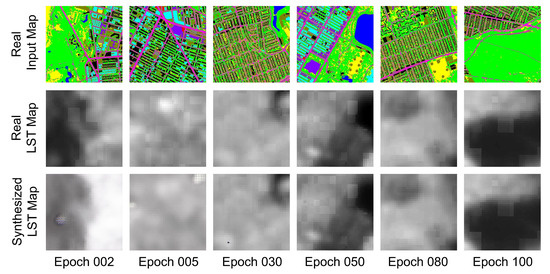
Figure 7.
Generated images of different training epochs.
In the early phase (epoch 002), generated LST maps show obvious blurriness and failed to accurately reflect the spatial distribution features of real data. As training advanced (from epoch 005 to epoch 080), however, generated images gradually developed local details and gradient variations akin to real data—especially at boundaries between buildings/environments and interfaces of blue–green spaces. This demonstrated a notable improvement in the model’s capability to capture input features. By epoch 100, generated image quality stabilized with minimal errors, indicating the model has fully learned the complex input–output relationships. To avoid overfitting, training is halted at epoch 100, where the model achieves optimal visual performance.
Although loss curves and visualizations provide intuitive insights into training dynamics, these metrics alone are insufficient to comprehensively assess the predictive capabilities of GAN models, especially in later training stages when visual discrimination may become unreliable. Therefore, this study systematically compares model performance across different training stages using both qualitative and quantitative metrics.
3. Results and Discussion
3.1. Accuracy Analysis
3.1.1. Qualitative Analysis
To assess GAN training effectiveness, we implement qualitative and quantitative methods to analyze prediction accuracy. To systematically validate GAN’s generalizability in predicting LST across urban spatial units, this study conducts cross-dataset performance evaluations. Qualitative assessments are based on prediction error distributions in training and test sets, with multidimensional comparisons of visualization results at different training epochs (Figure 8).
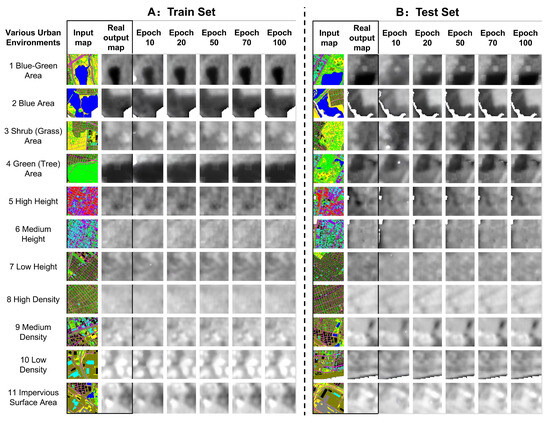
Figure 8.
(A): Re-generated images of the training set using models at different stages; (B): re-generated images of the test set using models at different stages. Each section includes an input map, a real output map, and the generated results for different training epochs (Epoch 010, Epoch 020, Epoch 050, Epoch 070, and Epoch 100).
As shown in Figure 8A, training set predictions demonstrate the model’s capability to reasonably predict LST distribution trends from input urban maps in most environments. In blue–green spaces (Figure 8(A1)), waterbody areas (Figure 8(A2)), grass-covered regions with high vegetation density (Figure 8(A3)), and tree canopy zones (Figure 8(A4)), the model accurately captures low-LST spatial patterns, reflecting significant cooling effects consistent with empirical distributions.
Importantly, architectural heterogeneity significantly influences model performance. In high-rise building areas (Figure 8(A5)), the model gradually develops the ability to identify localized low-LST zones. However, predictions for mid-rise (Figure 8(A6)) and low-rise buildings (Figure 8(A7)) exhibit slight blurring, potentially due to the incomplete capture of complex LST influences from height variations. In high-density built environments (Figure 8(A8)), the model effectively identifies partial low-LST zones but shows minor deviations in predicting high-LST hotspots, possibly related to UHI complexity. For mid-density (Figure 8(A9)) and low-density built areas (Figure 8(A10)), the model clearly predicts low-LST trends. In impervious surface-dominated regions (Figure 8(A11)), predictions are generally accurate but display localized inconsistencies.
Test set results (Figure 8B) indicate stable out-of-sample predictive performance, confirming practical applicability. Compared to the training set, test predictions exhibit sharper regional differentiation. Blue–green spaces (Figure 8(B1)) and waterbodies (Figure 8(B2)) show pronounced low-LST levels with high model–data consistency. The model successfully identifies concentrated low-LST distributions in high-rise (Figure 8(B5)) and high-density built areas (Figure 8(B8)). However, mid-rise (Figure 8(B6)) and mid-density zones (Figure 8(B9)) reveal minor detail prediction deficiencies. In waterfront impervious surfaces (Figure 8(B11)), while capturing overall LST trends, localized hotspot deviations persist, potentially attributable to industrial activity or functional complexity.
Epoch-wise comparisons (columns in Figure 8A,B) reveal evolving prediction accuracy. Specific regions (e.g., Figure 8(A1,A4,B1,B5)) demonstrate progressive accuracy improvements with increasing epochs. Conversely, other areas (e.g., Figure 8(A3,A7,B6,B7)) show minimal inter-epoch variation, with some (e.g., Figure 8(A6,A11,B11)) exhibiting declining training accuracy, suggesting potential overfitting requiring optimized training strategies.
3.1.2. Quantitative Analysis
In this study, the FID is calculated for both training and test sets to evaluate GAN model performance. FID is a critical metric for assessing the similarity between generated and real image feature distributions, with its calculation formula as follows:
where and denote the mean values of real and generated images, respectively, and and are their corresponding covariance matrices. The FID score quantifies the similarity between generated and real images by measuring both the mean discrepancy and distributional deviations through covariance matrices. Lower FID values correspond to better generation quality.
We computed FID values across epochs for both the training and test sets. Model selection primarily relied on test set performance, as it better reflects generalization capability. As shown in Figure 9, the boxplot visualizations clearly illustrate the distribution, variance, and outliers of FID values across epochs. The boxplots reveal that although epochs 50–70 exhibit relatively low variance, epoch 100 achieves both the lowest mean FID value and an acceptable level of variability, supporting its robustness. Furthermore, comparative analyses with the existing literature [51,92,98] indicate that the achieved FID values have reached a satisfactory level, which informed our decision to stop training at epoch 100 to avoid potential overfitting. Throughout training, the GAN model exhibited stable optimization dynamics, with no evidence of significant overfitting. Collectively, these results justify the selection of the epoch 100 model for subsequent experiments and analyses.
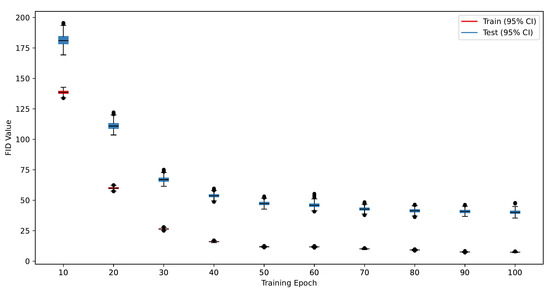
Figure 9.
FID boxplot comparing training and testing data over epochs.
3.2. Precision Analysis of GAN-Assisted Urban Design
Existing studies demonstrate that integrating water bodies and green spaces enhances mutual cooling potential [99,100,101,102], yet the underlying mechanisms remain unclear. Building upon the prior literature and experimental data, this study designed five simulation scenarios following the controlled variables principle, utilizing the optimized GAN model to explore optimal BGS configurations for maximizing urban land-use efficiency.
First, what proportion of blue–green space combinations yields the strongest urban cooling island (UCI) effects [101,103]? While threshold-based studies remain limited [28,104], we investigated optimal BGS ratios and cooling activation thresholds using the model.
Furthermore, the spatial arrangement of green infrastructure significantly influences BGS cooling efficacy in built environments [85]. For instance, street-aligned tree canopies or turf effectively reduce the LST [51,105]. The model enables a deeper exploration of how diverse spatial layouts modulate these relationships. Vegetation composition, particularly tree-to-turf coverage ratios, also impacts thermal regulation [106,107]. Research indicates tree and shrub coverage explains temperature differentials between parks and surrounding areas [108], while Hong Kong studies [109] show a 1 °C urban temperature reduction when tree-covered areas reach one-third of total space. This validates optimizing tree coverage as an effective urban cooling strategy, which we further examined through simulated vegetation composition variations.
Lastly, neighborhood building density critically affects cooling performance. Metrics like park cooling intensity (PCI) and park cooling area (PCA) link landscape features, building heights, and densities to thermal mitigation [110]. Positive correlations exist between the average LST and building density across urban blocks and urban green spaces (UGS) [71,72]. Building upon this foundation, we discuss BGS optimization schemes under varying building densities to elucidate their practical contributions to urban cooling.
3.2.1. Scenario 1: Optimizing Cooling Effects Through Blue–Green Space Ratios Under Fixed Total Area
This experiment aims to explore the impact of different UBGS ratios on the LST under fixed additional area conditions. It analyzes the cooling potential and differences of UBGS combinations to determine the optimal UBGS ratio for achieving the best cooling effect. The experiment sets a total increase of 1% in UBGS area, modifying 11 UBGS ratios (from Blue 0–Green 10 to Blue 10–Green 0).
On the basis of maintaining a consistent total new area, this study focuses on analyzing the mechanisms by which UBGS ratios affect cooling performance. An urban area map is selected, and a 10% total area (approximately 162 × 162 pixels or 26,244 pixels) is chosen as the study region to ensure that the increase in UBGS has a significant local environmental impact. The criteria for selecting the specific region include the following: (1) The study area should contain some impervious surfaces (such as buildings or roads) to accommodate new UBGS. (2) Ensure the selected area is large enough to statistically measure the impact of newly added UBGS pixels. (3) Avoid areas with dense existing green spaces to minimize interference from new greenspace additions. The additional UBGS is strictly limited to 2622 pixels, distributed over impervious surfaces to simulate the environmental impact of newly added green or water bodies in urban planning. The pixel allocation for new green and blue spaces strictly follows the proportions set in the experimental design. Photoshop (PS) is used, where histogram tools facilitate precise control of pixel counts to allocate proportions, ensuring comparability across each ratio combination.
To investigate the influence of distribution patterns, two sets of comparative data are designed (Figure 10). The first set manually adjusts UBGS ratios using contiguous block distributions, resembling actual urban planning scenarios. The second set uses Python-generated random dispersed single-pixel points. Comparing these two distribution patterns effectively reveals the critical role of distribution methods in UBGS design. The experiment utilizes LST prediction maps generated by the GAN model and calculates the average grayscale values of LST prediction maps under different ratios. Average grayscale values closer to 255 (white) indicate higher temperatures, while those closer to 0 (black) indicate lower temperatures. By comparing with real-world site LST maps (input map before), LST changes under different ratio combinations are obtained, and cooling effects (expressed as percentages: positive for cooling; negative for warming) are recorded. Specifically, “lower temperature” refers to the decrease in LST observed after layout modification, relative to the original input map (i.e., before modification). Experimental data are then used to analyze the impact of UBGS ratios on cooling performance.
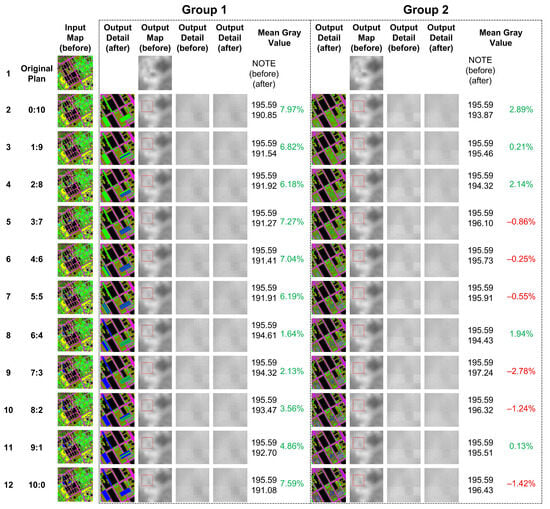
Figure 10.
(Group 1): Manually adjust the blue–green space ratio using contiguous block distributions to simulate real urban planning scenarios. (Group 2): Use randomly dispersed single-pixel points generated by Python 3.11.
The results show that (Figure 11) the manually designed Group 1 significantly outperforms the program-generated Group 2 in terms of cooling effectiveness. Specifically, Group 1 achieves the best cooling effects at Blue 0–Green 10 (7.97%) and Blue 10–Green 0 (7.59%), with an optimal combined ratio of Blue 3–Green 7 (7.27%). In contrast, Group 2 exhibits unstable cooling effects, with some ratios even causing temperature increases, such as Blue 7–Green 3 (−2.78%), Blue 8–Green 2 (−1.24%), and Blue 10–Green 0 (−1.42%). Further analysis of the cooling mechanisms of UBGS indicates that even single-pixel green spaces can significantly reduce local temperatures through transpiration, making them highly sensitive and efficient in cooling. Thus, increasing green coverage becomes a crucial strategy for addressing heat loads [111]. In contrast, blue spaces require continuous distribution over a certain area to exhibit cooling effects; when blue spaces are dispersed into single-pixel points, cooling effects may be lost or even cause warming. This suggests that the activation threshold for blue spaces is a critical factor in UBGS design. Moreover, manually designed distribution patterns not only more closely resemble actual urban settings but also enhance the synergistic effects of UBGS, effectively avoiding the experimental biases caused by single-pixel point distributions.
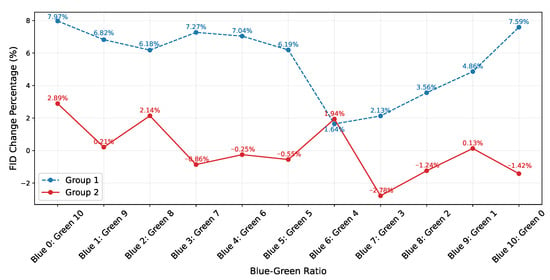
Figure 11.
Cooling line charts of the two groups of experiments under different blue–green ratios.
The experiment finds that high green space ratios (Blue 0–Green 10) achieve the best cooling effects, followed by blue space ratios (Blue 10–Green 0). The results also clarify ongoing debates about whether urban water bodies or green spaces have stronger cooling effects [103]. For instance, ref. [112] argues that green spaces are more beneficial for mitigating UHI effects than blue spaces. Many other studies based on LST suggest that urban water bodies have stronger cooling effects than green spaces [100,101,104]. Some research comparing water bodies and green space in Fuzhou, China [54], shows that water bodies provide stronger localized cooling, while green spaces offer broader temperature reductions. However, the synergistic effects of UBGS align better with urban planning needs. Additionally, further research is required to determine the minimum activation threshold for blue spaces to optimize the practical application of UBGS ratios. Future experiments should continue exploring UBGS distribution strategies, avoid the adverse effects of random dispersion on cooling performance, and apply optimized UBGS ratios to more complex scenarios.
3.2.2. Scenario 2: Determining Cooling Activation Thresholds for Blue Spaces via Pixel Cluster Size Optimization Under Fixed Total Area
This experiment aims to investigate the cooling activation threshold of blue spaces by determining their minimum area requirements, thereby establishing a scientific basis for subsequent UBGS ratio experiments. To address instability caused by single-pixel distributions, blue and green spaces are allocated as pixel clusters, simulating real-world contiguous waterbody and green space layouts (Figure 12). The experiment first loads the study area map and identifies impervious surface pixels (e.g., roads and bare soil) as available zones for UBGS addition, precisely marking pixel locations using a color-range mask (bare_soil_mask). Based on predefined UBGS ratio gradients (e.g., Blue 0–Green 100 to Blue 100–Green 0) and a total increment of 2262 pixels, blue and green pixel counts are calculated for each ratio and allocated into corresponding clusters.
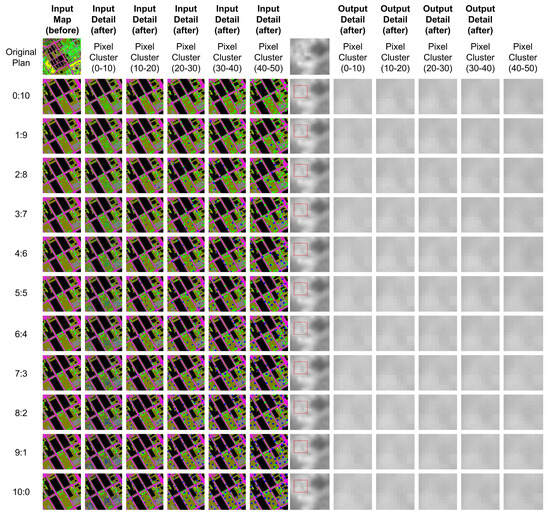
Figure 12.
Displays the cooling effects of five pixel clusters under different blue–green space ratios.
To investigate the cooling activation threshold of blue spaces, the experiment tested five pixel cluster size ranges (Figure 13): 0–10, 10–20, 20–30, 30–40, and 40–50 pixels. Preliminary results indicate the following: (1) Overall, larger pixel clusters (i.e., those with longer side lengths) are associated with more significant average cooling effects in UBGS settings; (2) Smaller pixel clusters (such as 10–20 and 20–30 pixels) generally fail to produce stable cooling across most ratio combinations, with some configurations even resulting in warming effects; (3) In contrast, 30–40 and 40–50 pixel clusters exhibit more consistent and substantial cooling performance, with no observed warming across all UBGS ratios.
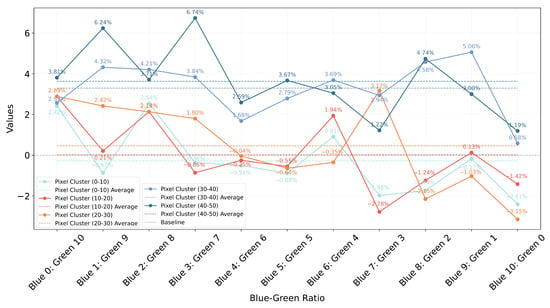
Figure 13.
Line graph of the cooling values of 5 pixel clusters at different blue–green ratios.
Notably, under a fully blue configuration (Blue 10–Green 0), the 30–40 pixel cluster performs closer to the baseline, suggesting it approaches the critical threshold for cooling activation. To further validate the stability of cooling performance, the test range was refined into two narrower intervals: 30–35 and 35–40 pixels (Figure 14). The results show that (Figure 15) while the 30–35 pixel cluster improves cooling to some extent, minor instability persists. For instance, in the Blue 6–Green 4 combination, the cooling rate is only −0.50%, and in the fully blue scenario, the cooling effect remains insufficient at −3.99%. In contrast, the 35–40 pixel cluster completely eliminates warming and achieves a 0.12% cooling effect under full-blue conditions. This range is therefore identified as the minimum activation threshold for effective cooling of blue spaces.
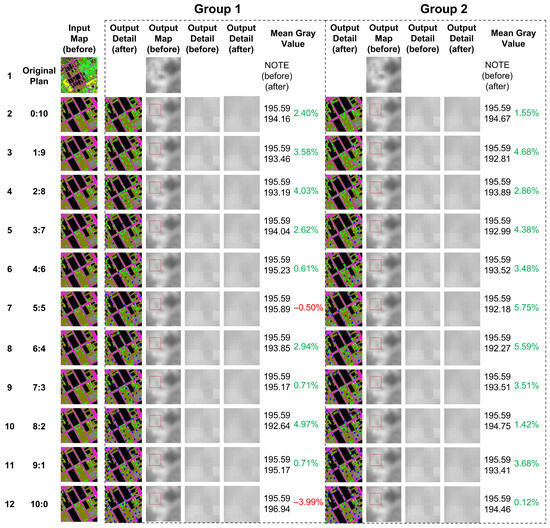
Figure 14.
(Group 1): 30–35 pixel clusters; (Group 2): 35–40 pixel clusters.
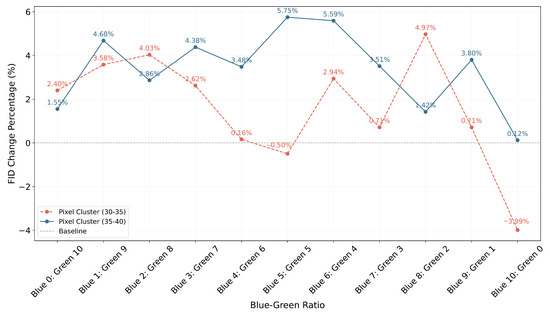
Figure 15.
Line graph illustrating threshold variations of two pixel cluster groups (30–35 vs. 35–40 pixels) across blue–green space ratio gradients.
Therefore, the experimental results recommend adopting a minimum unit size of 35–40 pixels (approximately 218–250 m2) for effective cooling analysis. It is important to emphasize that this threshold is not a fixed empirical value, but rather a critical foundation for subsequent experiments. It helps prevent underestimation of the cooling potential of blue spaces due to insufficient area, thereby ensuring the accuracy and reliability of evaluations under different UBGS configurations. This spatial unit also aligns more closely with practical urban planning practices, enhancing the applicability of the findings.
It is worth noting that, in comparison with previous studies on cooling thresholds [28], this study offers a microscale estimation based on high-resolution pixel-level analysis, whereas prior research has largely focused on macroscale minimum area requirements. For instance, Zhou et al. [104] proposed ToCabs thresholds of 5–10 ha for water bodies and 20–50 ha for forests; Zhang et al. [113] identified thresholds of 82.37 ha and 2.56 ha based on PCA and PCE analyses; Xu et al. [114] found that medium-sized UGS (0.3–0.8 ha) provides optimal cooling effects; Yao et al. [115] calculated an efficiency threshold (TVoE) of 1.08 ha based on park cooling gradients; and Fan et al. [116] reported optimal green space sizes of 0.92–0.96 ha in high-vegetation, high-temperature cities and 0.60–0.62 ha in low-vegetation, low-temperature cities.
These differences should not be seen as contradictions but as reflections of scale-dependent effects arising under varying research contexts, influenced by factors such as study region, data resolution, land cover classification, and analytical methodologies. Accordingly, future research is encouraged to systematically investigate the translation and integration of thresholds across spatial scales, with the aim of optimizing multiscale cooling outcomes, enhancing cross-study comparability, and providing more targeted theoretical frameworks and practical guidance for urban blue–green space planning.
3.2.3. Scenario 3: How Do Different Blue–Green Space Layouts Affect Localized Cooling Under Fixed BGS Ratios, and What Is the Optimal Strategy?
This experiment builds upon prior findings by using a fixed UBGS ratio of 3:7 to investigate how different spatial layouts influence localized LST reduction (Figure 16). The goal is to analyze variations in cooling efficacy across layouts and identify optimal urban UBGS design strategies. Five typical layouts are evaluated: Concentrated–Spot (UBGS concentrated in point-like zones, simulating parks or plazas), Scattered–Linear (evenly distributed along linear corridors, mimicking street greenery or rivers), Concentrated–Linear (aggregated in large linear zones, resembling continuous green belts along arterial roads), Scattered–Random (randomly dispersed across the study area, replicating fragmented small green/blue patches), and Mixed (a balanced combination of clustered and dispersed distributions). Importantly, all layouts maintain identical total UBGS area and ratios, with spatial arrangements adjusted to simulate real-world urban design scenarios.
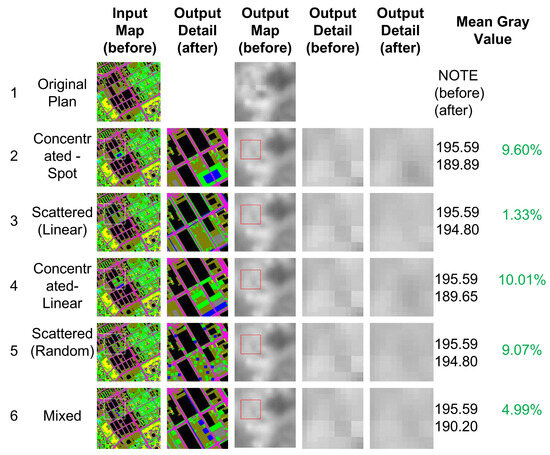
Figure 16.
Comparative analysis of cooling efficacy across six spatial distribution modes of blue–green space under a fixed 3:7 proportionality.
Using predictive models, we quantified LST changes by comparing pre- and post-intervention mean grayscale values. The results reveal significant cooling variations among layout types. Concentrated–Linear achieves the highest LST reduction at 10.01%, demonstrating superior cooling capacity through large-scale linear aggregation and effectively simulating continuous green belts. Concentrated–Spot follows closely with a 9.60% reduction, showing that smaller, discrete green areas can still offer substantial benefits. Scattered–Random achieves 9.07%, indicating that even fragmented patches can contribute to cooling, albeit less effectively than clustered designs. In contrast, Scattered–Linear performs weakest, with only a 1.33% reduction, likely due to diminished synergistic effects caused by excessive dispersion. Mixed layouts yield moderate cooling (4.99%), combining the advantages of clustered and dispersed arrangements, but they do not match the efficacy of fully concentrated configurations.
These findings align with existing research highlighting the dominance of compact green space morphology in cooling performance [101]. The results validate the importance of vertical and linear aggregation strategies for LST mitigation and offer actionable insights for urban planning, particularly in functionally zoned areas that require tailored UBGS designs. To provide an overall statistical summary, we calculated the average cooling percentage (7.00%), sample variance (0.0014), and standard deviation (0.0375) across all layout types. While preliminary, these findings offer valuable insights into performance differences and variability, reinforcing the importance of spatial layout optimization in maximizing cooling potential and enhancing urban livability.
3.2.4. Scenario 4: How Do Vegetation Species Configurations Within Green Spaces Influence LST Under Fixed BGS Ratios (3:7) and Clustered–Linear Layouts?
This experiment investigates how plant species configurations within green spaces influence LST. By analyzing the effects of varying tree canopy (arboreal vegetation) and shrub/grass ratios on cooling performance, this study aims to identify optimal vegetation composition strategies for urban thermal regulation.
The experimental design categorizes green spaces into two vegetation types: tree canopy and shrub/grass (Figure 17). First, shrub coverage is incrementally increased from 20% to 100% to evaluate its impact on LST. Subsequently, tree canopy coverage is adjusted from 20% to 100% under fixed conditions to assess its cooling efficacy.
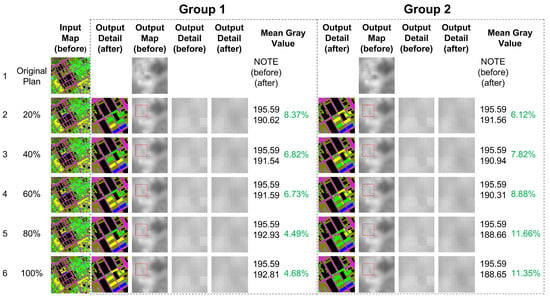
Figure 17.
(Group 1): Effects of treecanopy coverage gradients on temperature modulation; (Group 2): Effects of shrub/grass coverage gradients on temperature modulation.
Results reveal significant differences in cooling performance across vegetation compositions. In shrub-dominated configurations, cooling effects slightly decrease with higher shrub ratios. At 80% shrub coverage, LST reduction reaches its minimum (mean grayscale change: 4.49%). In contrast, tree canopy-dominated configurations exhibit enhanced cooling as coverage increases, peaking at 80% tree canopy coverage (mean grayscale change: 11.66%). However, further increasing tree canopy to 100% slightly reduces cooling efficacy (mean grayscale change: 11.35%), indicating an optimal threshold at 80% tree coverage. This finding aligns with prior studies demonstrating superior cooling at a 2:8 shrub-to-tree canopy ratio [51].
Mechanistic analysis highlights distinct thermal regulation pathways between shrubs and trees. Shrubs primarily rely on ground-level evapotranspiration and surface shading, showing notable cooling at lower ratios (20–60%) but limited efficacy at higher densities. Tree canopies, however, excel through elevated evapotranspiration, extensive shading, and vertical solar radiation interception. Excessive tree density (>80%) may impede near-surface airflow, reducing evaporative efficiency and slightly diminishing cooling performance.
Despite proportional equivalence in certain configurations (e.g., 20% shrub vs. 80% tree canopy), cooling disparities persist due to differences in three-dimensional spatial distribution and functional traits. Tree canopies, with their vertical height, effectively block solar radiation, while shrubs influence surface heat absorption through horizontal ground coverage. Both vegetation types exhibit nonlinear LST modulation, suggesting complex threshold-driven interactions. For instance, synergistic or antagonistic effects between species may amplify or weaken cooling depending on specific ratios.
Synthesizing the findings, tree-dominated configurations (80% canopy coverage) in Clustered–Linear layouts achieve maximal cooling, consistent with studies prioritizing arboreal vegetation for urban heat mitigation [101,103,104,117]. Shrub/grass configurations, while supplementary, show limited standalone efficacy. These insights underscore the importance of prioritizing tree canopy coverage in parks, plazas, and other areas requiring significant cooling. In space-constrained environments (e.g., streets; high-density zones), hybrid shrub-tree configurations can balance thermal regulation with ecological and aesthetic diversity.
This research provides actionable guidelines for optimizing urban green space design, harmonizing functional requirements with climate resilience objectives. By integrating species-specific thermal regulation mechanisms into spatial planning, cities can enhance microclimate management while fostering sustainable urban ecosystems.
3.2.5. Scenario 5: Consistency of Optimal Configuration Across Neighborhood Typologies and Key Influencing Factors
This experiment applies the previously identified optimal UBGS configuration (Blue 3–Green 7 ratio, shrub-to-tree ratio 2:8, Concentrated–Linear layout) to diverse neighborhood types, evaluating its LST regulation efficacy under varying building densities, heights, layouts, and mixed height–density conditions (Figure 18). The core objectives are to determine the consistency of cooling effects across urban morphologies and identify key influencing factors.
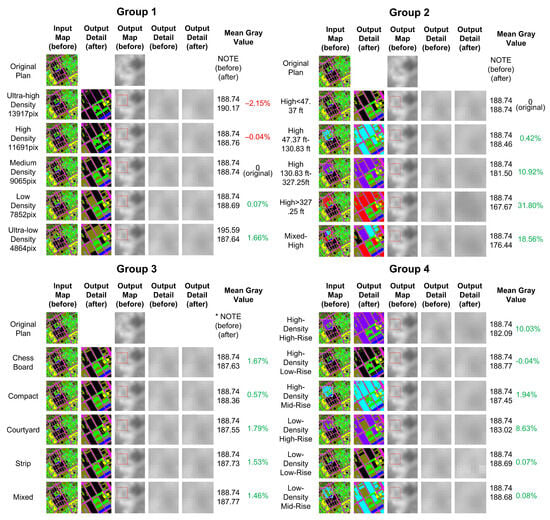
Figure 18.
(Group 1): Urban blocks with varyingbuilding densities. (Group 2): Urban blocks with varying building heights. (Group 3): Urban blocks with varying building layouts. (Group 4): Urban blocks with varying combinations of density and height.
Prior to the experiment, we defined the building layouts and densities to ensure comparability across scenarios. Specifically, the chessboard layout refers to an alternating, regular arrangement of buildings and open spaces, resembling a chessboard. The compact layout is characterized by tightly packed buildings and high land-use efficiency, forming an intensive urban fabric. The courtyard layout consists of semi- or fully enclosed courtyards surrounded by buildings, emphasizing central open space as well as natural ventilation and sunlight. The strip layout features buildings arranged linearly along a main axis, typically forming continuous street blocks or green belts. The mixed layout combines multiple types, such as chessboard, courtyard, and strip configurations, to reflect spatial diversity.
In terms of building density, the experiment adopts a multi-level classification system and uses pixel counts to delineate density zones in the study area. The density categories include the following: ultra-low density (≤20%), low density (20–30%), medium density (30–40%), high density (40–50%), and ultra-high density (≥50%). The study area contains 26,244 pixels, of which 9065 are building pixels, yielding an initial building density of approximately 34.54%, within the medium-density range. To meet the target distribution, pixel adjustments were applied across categories: for example, the ultra-high density zone required adding 4057 pixels, the high-density zone 120 pixels, while the low- and ultra-low density zones required reducing 1192 and 3817 pixels, respectively. This pixel-level adjustment effectively calibrates the proportional distribution of density types, ensuring the experimental scenarios align with the diversity of real-world urban patterns and improving the applicability and reliability of the simulation results.
Building Density Impacts: Cooling effects intensify with reduced building density. Ultra-high density neighborhoods exhibit a grayscale value change of −2.15% (indicating slight warming), while ultra-low density areas achieve 1.66% cooling. This demonstrates that BGS efficacy is constrained in ultra-dense environments but fully realized in low-density settings, aligning with studies advocating density reduction as a core UHI mitigation strategy.
Building Height Impacts: Cooling performance scales with building height. Super-tall neighborhoods (>327.25 ft) show a 31.80% grayscale reduction, contrasting with minimal 0.42% changes in low-rise areas (<47.37 ft). Mixed-height neighborhoods achieve 18.56% cooling, inferior to homogeneous super-tall configurations. LST analysis confirms significantly lower absolute temperatures in super tall areas, proving BGS configurations’ dual capacity to enhance cooling magnitude and reduce baseline thermal loads.
Building Layout Impacts: Courtyard layouts achieve peak cooling (1.79% grayscale reduction), while compact layouts perform worst (0.57%). Intermediate results include chessboard (1.67%), strip (1.53%), and mixed layouts (1.46%). Open layouts like courtyards enhance airflow and vegetation efficacy, whereas enclosed configurations limit BGSs potential.
Height–Density Interaction Impacts: High-density/high-rise combinations yield maximal cooling (10.03%), followed by low-density/high-rise combinations (8.63%). High-density/low-rise areas show negligible effects (–0.04%), with low-density/low-rise areas being marginally effective (0.07–0.08%). This highlights height–density synergy: high-rise structures amplify BGS cooling regardless of density, while low-rise configurations underperform across density gradients.
Results reveal significant LST regulation variability across neighborhood types despite identical UBGS configurations. Building height exerts a stronger influence on cooling efficacy than building density. Particularly, in high-rise neighborhoods, the cooling capacity of UBGS is fully realized. Analysis of grayscale images shows that high-rise neighborhoods not only exhibit greater cooling magnitudes but also significantly lower absolute LST values compared to low-rise neighborhoods. This indicates that high-rise neighborhoods benefit more from UBGS configurations in reducing actual heat levels.
In contrast, while reducing building density can improve cooling effects, its impact is relatively weaker, especially in low-rise neighborhoods where the effectiveness of UBGS is more limited. Additionally, the openness and consistency of building layouts play a crucial role in enhancing cooling effects. Courtyard layouts perform best, while compact layouts are the weakest.
Interestingly, both high-density/high-rise and low-density/high-rise typologies demonstrate superior cooling effects compared to other types of neighborhoods. This suggests that an appropriate combination of building height and density significantly enhances the efficacy of UBGS. Therefore, urban design should prioritize optimizing UBGS configurations in existing high-rise neighborhoods to fully utilize their cooling potential.
Based on experimental results, the following aspects are recommended for achieving more significant LST regulation in urban design: Optimize UBGS Configurations in High-Rise Areas: Prioritize improving the UBGS ratios and layout designs in existing high-rise areas to maximize their cooling capacity. Adopt Open Layouts: Prefer open layouts such as courtyards over enclosed patterns like compact arrangements to improve air circulation and vegetation coverage.
4. Conclusions
This study aims to explore the impact of various UBGS configurations on LST distribution and to develop a data-driven modeling tool to support climate-adaptive urban design. To this end, we propose a UBGS modeling framework that integrates multi-source geographic data from NYC (LiDAR, OSM, building footprints, etc.) with Landsat-derived LST data. A GAN-based model is trained to rapidly produce visualized LST maps under different spatial planning scenarios. This approach not only demonstrates strong predictive capabilities in image-based tasks but also offers a scientific decision-support tool for future urban spatial optimization and climate adaptation.
Key findings include: (1) Regarding spatial ratios, the most effective cooling outcome is achieved with a UBGS ratio of 3:7 and a shrub-to-tree ratio of 2:8, with tree-dominated configurations outperforming shrub-dominated ones. (2) In terms of spatial layout, linear and concentrated configurations show the highest cooling potential (up to 10.01%), while courtyard layouts provide collaborative and ventilation benefits, and compact layouts perform the worst. (3) For building characteristics, high-rise areas exhibit significantly better cooling performance than low-rise areas, with improvements of up to 31 percentage points in super-high-rise districts, indicating that building height has a greater impact on cooling effects than building density.
Moreover, the UBGS optimization strategies proposed in this study align closely with international climate and urban development frameworks such as those of the IPCC and UN-Habitat [118]. By promoting nature-based solutions (NbSs) [119], the framework supports enhancing urban resilience to climate change and demonstrates strong potential for policy integration and practical application.
Despite the promising outcomes of this study, several limitations remain. The current GAN framework demonstrates strong capabilities in rapidly exploring diverse spatial scenarios but lacks a mathematically defined global optimum. Furthermore, its output is based on image pixel values ranging from 0 to 255, which imposes an inherent limitation on numerical precision. Future research could explore the use of floating-point image representations, multi-channel encoding methods, or regression-based neural network architectures to improve the accuracy and generalizability of model outputs.
Author Contributions
Conceptualization, H.Z. and Y.L.; methodology, H.Z.; software, H.Z.; validation, L.Z.; formal analysis, L.Z.; investigation, Y.L.; resources, H.Z.; data curation, H.Z.; writing—original draft preparation, Y.L.; writing—review and editing, Y.L.; visualization, L.Z.; supervision, X.Y.; project administration, X.Y.; funding acquisition, X.Y. All authors have read and agreed to the published version of the manuscript.
Funding
This research was funded by the Fundamental Research Funds for the Central Universities (Project No. 02040022123003) from Northeastern University of China, and the New Faculty Start-up Grant (Project No. 9610653) from the City University of Hong Kong.
Data Availability Statement
The data presented in this study are available on request from the corresponding author.
Conflicts of Interest
The authors declare no conflicts of interest.
References
- Li, B.; Zhang, Y.; Zhao, S.; Zhao, L.; Wang, M.; Pei, H. Urban Heat Island Effect in Different Sizes from a 3D Perspective: A Case Study in the Beijing–Tianjin–Hebei Region. Land 2025, 14, 463. [Google Scholar] [CrossRef]
- Kim, K.K.; Choi, Y.S.; Lee, H.J.; Rodrigazo, S.A.; Yeon, J. Enhanced Thermal Resistance and Mechanical Performance of Methyl Methacrylate-Based Pavement Coatings for Urban Heat Mitigation. Polymers 2025, 17, 586. [Google Scholar] [CrossRef] [PubMed]
- Manoli, G.; Fatichi, S.; Schläpfer, M.; Yu, K.; Crowther, T.W.; Meili, N.; Burlando, P.; Katul, G.G.; Bou-Zeid, E. Magnitude of urban heat islands largely explained by climate and population. Nature 2019, 573, 55–60. [Google Scholar] [CrossRef] [PubMed]
- Zhao, L.; Lee, X.; Smith, R.B.; Oleson, K. Strong contributions of local background climate to urban heat islands. Nature 2014, 511, 216–219. [Google Scholar] [CrossRef]
- Tziampou, N.; Coupe, S.J.; Sañudo-Fontaneda, L.A.; Newman, A.P.; Castro-Fresno, D. Fluid transport within permeable pavement systems: A review of evaporation processes, moisture loss measurement and the current state of knowledge. Constr. Build. Mater. 2020, 243, 118179. [Google Scholar] [CrossRef]
- Zhang, S.; Guo, Y. SWMM simulation of the storm water volume control performance of permeable pavement systems. J. Hydrol. Eng. 2015, 20, 06014010. [Google Scholar] [CrossRef]
- Qiu, L.; Wu, Y.; Yu, M.; Shi, Z.; Yin, X.; Song, Y.; Sun, K. Contributions of vegetation restoration and climate change to spatiotemporal variation in the energy budget in the loess plateau of china. Ecol. Indic. 2021, 127, 107780. [Google Scholar] [CrossRef]
- Sailor, D.J. A review of methods for estimating anthropogenic heat and moisture emissions in the urban environment. Int. J. Climatol. 2011, 31, 189–199. [Google Scholar] [CrossRef]
- Zhang, Y.; Murray, A.T.; Turner Ii, B. Optimizing green space locations to reduce daytime and nighttime urban heat island effects in Phoenix, Arizona. Landsc. Urban Plan. 2017, 165, 162–171. [Google Scholar] [CrossRef]
- Klein, T.; Anderegg, W.R. A vast increase in heat exposure in the 21st century is driven by global warming and urban population growth. Sustain. Cities Soc. 2021, 73, 103098. [Google Scholar] [CrossRef]
- Yang, J.; Yin, P.; Sun, J.; Wang, B.; Zhou, M.; Li, M.; Tong, S.; Meng, B.; Guo, Y.; Liu, Q. Heatwave and mortality in 31 major Chinese cities: Definition, vulnerability and implications. Sci. Total Environ. 2019, 649, 695–702. [Google Scholar] [CrossRef] [PubMed]
- Liu, J.; Qi, J.; Yin, P.; Liu, W.; He, C.; Gao, Y.; Zhou, L.; Zhu, Y.; Kan, H.; Chen, R.; et al. Rising cause-specific mortality risk and burden of compound heatwaves amid climate change. Nat. Clim. Change 2024, 14, 1201–1209. [Google Scholar] [CrossRef]
- Ho, J.Y.; Shi, Y.; Lau, K.K.; Ng, E.Y.; Ren, C.; Goggins, W.B. Urban heat island effect-related mortality under extreme heat and non-extreme heat scenarios: A 2010–2019 case study in Hong Kong. Sci. Total Environ. 2023, 858, 159791. [Google Scholar] [CrossRef]
- Xi, D.; Liu, L.; Zhang, M.; Huang, C.; Burkart, K.G.; Ebi, K.; Zeng, Y.; Ji, J.S. Risk factors associated with heatwave mortality in Chinese adults over 65 years. Nat. Med. 2024, 30, 1489–1498. [Google Scholar] [CrossRef]
- Lüthi, S.; Fairless, C.; Fischer, E.M.; Scovronick, N.; Armstrong, B.; Coelho, M.D.S.Z.S.; Guo, Y.L.; Guo, Y.; Honda, Y.; Huber, V.; et al. Rapid increase in the risk of heat-related mortality. Nat. Commun. 2023, 14, 4894. [Google Scholar] [CrossRef]
- Magli, S.; Lodi, C.; Lombroso, L.; Muscio, A.; Teggi, S. Analysis of the urban heat island effects on building energy consumption. Int. J. Energy Environ. Eng. 2015, 6, 91–99. [Google Scholar] [CrossRef]
- Li, X.; Zhou, Y.; Yu, S.; Jia, G.; Li, H.; Li, W. Urban heat island impacts on building energy consumption: A review of approaches and findings. Energy 2019, 174, 407–419. [Google Scholar] [CrossRef]
- Tao, C.; Zhang, Q.; Huo, S.; Ren, Y.; Han, S.; Wang, Q.; Wang, W. PM2. 5 pollution modulates the response of ozone formation to VOC emitted from various sources: Insights from machine learning. Sci. Total Environ. 2024, 916, 170009. [Google Scholar] [CrossRef]
- Wang, Y.; Guo, Z.; Han, J. The relationship between urban heat island and air pollutants and them with influencing factors in the Yangtze River Delta, China. Ecol. Indic. 2021, 129, 107976. [Google Scholar] [CrossRef]
- Feng, Z.; Wang, X.; Yu, M.; Yuan, Y.; Li, B. PM2. 5 reduces the daytime/nighttime urban heat island intensity over mainland China. Sustain. Cities Soc. 2025, 118, 106001. [Google Scholar] [CrossRef]
- United Nations, Department of Economic and Social Affairs, Population Division. World Urbanization Prospects: The 2018 Revision, Online Edition; UN DESA: New York, NY, USA, 2018; Available online: https://population.un.org/wup/ (accessed on 26 February 2025).
- Sun, L.; Chen, J.; Li, Q.; Huang, D. Dramatic uneven urbanization of large cities throughout the world in recent decades. Nat. Commun. 2020, 11, 5366. [Google Scholar] [CrossRef]
- Bhattacharyya, S.; Sinha, S.; Kumari, M.; Mishra, V.N.; Hasher, F.F.B.; Szostak, M.; Zhran, M. Spatio-Temporal Influences of Urban Land Cover Changes on Thermal-Based Environmental Criticality and Its Prediction Using CA-ANN Model over Kolkata (India). Remote Sens. 2025, 17, 1082. [Google Scholar] [CrossRef]
- Liu, D.; Zhou, R.; Ma, Q.; He, T.; Fang, X.; Xiao, L.; Hu, Y.; Li, J.; Shao, L.; Gao, J. Spatio-temporal patterns and population exposure risks of urban heat island in megacity Shanghai, China. Sustain. Cities Soc. 2024, 108, 105500. [Google Scholar] [CrossRef]
- Rahimi, D.; Kii, M.; Shimadera, H.; Causone, F. Exploring Seasonal and Diurnal Variations of the Thermal Environment in Metropolitan Scale Analysis Based on Remote Sensing Data. Remote Sens. 2025, 17, 1210. [Google Scholar] [CrossRef]
- Han, M.; Zhang, T.; Si, Z. Optimizing urban blue-green space in climate adaptive planning: A systematic review of threshold value of efficiency thresholds. Landsc. Ecol. 2025, 40, 13. [Google Scholar] [CrossRef]
- Fang, Y.; Zhao, L. Exploring the supply-demand match and drivers of blue-green spaces cooling in Wuhan Metropolis. Urban Clim. 2024, 58, 102194. [Google Scholar] [CrossRef]
- Yu, Z.; Yang, G.; Zuo, S.; Jørgensen, G.; Koga, M.; Vejre, H. Critical review on the cooling effect of urban blue-green space: A threshold-size perspective. Urban For. Urban Green. 2020, 49, 126630. [Google Scholar] [CrossRef]
- Yin, J.; Ramanpong, J.; Chang, J.; Wu, C.D.; Chao, P.H.; Yu, C.P. Effects of blue space exposure in urban and natural environments on psychological and physiological responses: A within-subject experiment. Urban For. Urban Green. 2023, 87, 128066. [Google Scholar] [CrossRef]
- Zhang, L.; Meng, Q.; Yao, S.; Qian, J.; Gao, J.; Wu, J. How to optimize urban blue space to maximize its cooling benefits? A case study in megacity of Beijing. Build. Environ. 2025, 270, 112502. [Google Scholar] [CrossRef]
- Zhang, L.; Wang, S.; Zhai, W.; He, Z.; Shi, W.; Li, Y.; Zhao, C. How does Blue-Green Infrastructure affect the urban thermal environment across various functional zones? Urban For. Urban Green. 2025, 105, 128698. [Google Scholar] [CrossRef]
- Chen, Y.; La Rosa, D.; Yue, W. Does urban sprawl lessen green space exposure? Evidence from Chinese cities. Landsc. Urban Plan. 2025, 257, 105319. [Google Scholar] [CrossRef]
- Zheng, Y.; Li, Y.; Hou, H.; Murayama, Y.; Wang, R.; Hu, T. Quantifying the cooling effect and scale of large inner-city lakes based on landscape patterns: A case study of Hangzhou and Nanjing. Remote Sens. 2021, 13, 1526. [Google Scholar] [CrossRef]
- Yao, L.; Sailor, D.J.; Zhang, X.; Wang, J.; Zhao, L.; Yang, X. Diurnal pattern and driving mechanisms of the thermal effects of an urban pond. Sustain. Cities Soc. 2023, 91, 104407. [Google Scholar] [CrossRef]
- Lin, Z.; Xu, H.; Yao, X.; Yang, C.; Yang, L. Exploring the relationship between thermal environmental factors and land surface temperature of a “furnace city” based on local climate zones. Build. Environ. 2023, 243, 110732. [Google Scholar] [CrossRef]
- Hao, T.; Zhao, Q.; Huang, J. Optimization of tree locations to reduce human heat stress in an urban park. Urban For. Urban Green. 2023, 86, 128017. [Google Scholar] [CrossRef]
- Cheng, K.Y.; Lau, K.; Shek, Y.T.; Liu, Z.; Ng, E. Evaluation on the performance of tree view factor in a high-density subtropical city: A case study in Hong Kong. Build. Environ. 2023, 239, 110431. [Google Scholar] [CrossRef]
- Sarfo, I.; Bi, S.; Xu, X.; Yeboah, E.; Kwang, C.; Batame, M.; Addai, F.K.; Adamu, U.W.; Appea, E.A.; Djan, M.A.; et al. Planning for cooler cities in Ghana: Contribution of green infrastructure to urban heat mitigation in Kumasi Metropolis. Land Use Policy 2023, 133, 106842. [Google Scholar] [CrossRef]
- Di Marino, M.; Cucca, R.; Thaler, T.; Bügelmayer-Blaschek, M. Interlinking the silos: How to stimulate a new debate on more greenery in cities. Urban For. Urban Green. 2023, 87, 128065. [Google Scholar] [CrossRef]
- Abd-Elmabod, S.K.; Gui, D.; Liu, Q.; Liu, Y.; Al-Qthanin, R.N.; Jiménez-González, M.A.; Jones, L. Seasonal environmental cooling benefits of urban green and blue spaces in arid regions. Sustain. Cities Soc. 2024, 115, 105805. [Google Scholar] [CrossRef]
- Fu, W.; Li, Y.; Halik, Ü.; Tian, A.; Ainiwaer, A.; Liu, Y.; Wei, Z.; Shi, L.; Welp, M. Selection and performance evaluation of roof materials in arid oasis cities: The advantages of white polymer materials. Build. Environ. 2025, 267, 112282. [Google Scholar] [CrossRef]
- Zhuo, S.; Zhou, W.; Fang, P.; Ye, J.; Luo, H.; Li, H.; Wu, C.; Chen, W.; Liu, Y. Cost-effective pearlescent pigments with high near-infrared reflectance and outstanding energy-saving ability for mitigating urban heat island effect. Appl. Energy 2024, 353, 122051. [Google Scholar] [CrossRef]
- Basyouni, Y.A.; Mahmoud, H. Affordable green materials for developed cool roof applications: A review. Renew. Sustain. Energy Rev. 2024, 202, 114722. [Google Scholar] [CrossRef]
- Lau, T.K.; Tsai, P.C.; Ou, H.Y.; Lin, T.P. Efficient and cost-effective method for identifying urban ventilation corridors using a heuristic search algorithm. Sustain. Cities Soc. 2024, 101, 105144. [Google Scholar] [CrossRef]
- Zhang, X.; Liu, Y.; Chen, Y.; Liu, J. Identification and integration of ventilation corridors in Shijiazhuang City, China. Sustain. Cities Soc. 2024, 112, 105543. [Google Scholar] [CrossRef]
- Liu, J.; She, X.; Wang, J. Comprehensive optimization of urban building cluster morphology based on microclimate: A two-level optimization approach. Sustain. Cities Soc. 2024, 100, 105005. [Google Scholar] [CrossRef]
- Lai, Z.; He, J.; Li, Y. Potential zones identification for district cooling system: A GIS-based multi-criteria assessment method incorporating cooling demand mapping. Sustain. Cities Soc. 2024, 105, 105327. [Google Scholar] [CrossRef]
- Wikipedia. Million Tree Initiative; Wikipedia: San Francisco, CA, USA, 2025; Available online: https://en.wikipedia.org/wiki/Million_Tree_Initiative (accessed on 26 February 2025).
- Landscape Performance Institute. Cheonggyecheon Stream Restoration Project. Landscape Performance Series. 2025. Available online: https://www.landscapeperformance.org/case-study-briefs/cheonggyecheon-stream-restoration-project (accessed on 26 February 2025).
- CBD News Australia. City of Melbourne Unveils Next Urban Forest Plan for the CBD; CBD News Australia: Melbourne, Australia, 2025; Available online: https://www.cbdnews.com.au/city-of-melbourne-unveils-next-urban-forest-plan-for-the-cbd (accessed on 26 February 2025).
- Li, Q.; Zheng, H. Prediction of summer daytime land surface temperature in urban environments based on machine learning. Sustain. Cities Soc. 2023, 97, 104732. [Google Scholar] [CrossRef]
- Tanoori, G.; Soltani, A.; Modiri, A. Machine learning for urban heat island (UHI) analysis: Predicting land surface temperature (LST) in urban environments. Urban Clim. 2024, 55, 101962. [Google Scholar] [CrossRef]
- Azhdari, A.; Soltani, A.; Alidadi, M. Urban morphology and landscape structure effect on land surface temperature: Evidence from Shiraz, a semi-arid city. Sustain. Cities Soc. 2018, 41, 853–864. [Google Scholar] [CrossRef]
- Cai, Y.B.; Wu, Z.J.; Chen, Y.H.; Wu, L.; Pan, W.B. Investigate the difference of Cooling effect between water Bodies and green spaces: The study of Fuzhou, China. Water 2022, 14, 1471. [Google Scholar] [CrossRef]
- Maimaitiyiming, M.; Ghulam, A.; Tiyip, T.; Pla, F.; Latorre-Carmona, P.; Halik, Ü.; Sawut, M.; Caetano, M. Effects of green space spatial pattern on land surface temperature: Implications for sustainable urban planning and climate change adaptation. ISPRS J. Photogramm. Remote Sens. 2014, 89, 59–66. [Google Scholar] [CrossRef]
- Cao, S.; Wang, Y.; Ni, Z.; Xia, B. Effects of blue-green infrastructures on the microclimate in an urban residential area under hot weather. Front. Sustain. Cities 2022, 4, 824779. [Google Scholar] [CrossRef]
- Verhagen, W.; Van Teeffelen, A.J.; Baggio Compagnucci, A.; Poggio, L.; Gimona, A.; Verburg, P.H. Effects of landscape configuration on mapping ecosystem service capacity: A review of evidence and a case study in Scotland. Landsc. Ecol. 2016, 31, 1457–1479. [Google Scholar] [CrossRef]
- Budzik, G.; Sylla, M.; Kowalczyk, T. Understanding Urban Cooling of Blue–Green Infrastructure: A Review of Spatial Data and Sustainable Planning Optimization Methods for Mitigating Urban Heat Islands. Sustainability 2025, 17, 142. [Google Scholar] [CrossRef]
- Lin, Y.; Wang, Z.; Jim, C.Y.; Li, J.; Deng, J.; Liu, J. Water as an urban heat sink: Blue infrastructure alleviates urban heat island effect in mega-city agglomeration. J. Clean. Prod. 2020, 262, 121411. [Google Scholar] [CrossRef]
- Yan, L.; Jia, W.; Zhao, S. The cooling effect of urban green spaces in metacities: A case study of Beijing, China’s capital. Remote Sens. 2021, 13, 4601. [Google Scholar] [CrossRef]
- Qiu, X.; Kil, S.H.; Jo, H.K.; Park, C.; Song, W.; Choi, Y.E. Cooling effect of urban blue and green spaces: A case study of Changsha, China. Int. J. Environ. Res. Public Health 2023, 20, 2613. [Google Scholar] [CrossRef]
- Du, H.; Cai, Y.; Zhou, F.; Jiang, H.; Jiang, W.; Xu, Y. Urban blue-green space planning based on thermal environment simulation: A case study of Shanghai, China. Ecol. Indic. 2019, 106, 105501. [Google Scholar] [CrossRef]
- Zhang, Y.; Wang, Y.; Ding, N. Spatial effects of landscape patterns of urban patches with different vegetation fractions on urban thermal environment. Remote Sens. 2022, 14, 5684. [Google Scholar] [CrossRef]
- Rezaei Rad, H.; Rafieian, M.; Sozer, H. Evaluating the effects of increasing of building height on land surface temperature. Int. J. Urban Manag. Energy Sustain. 2019, 1, 37–42. [Google Scholar]
- Wang, M.; Xu, H. The impact of building height on urban thermal environment in summer: A case study of Chinese megacities. PLoS ONE 2021, 16, e0247786. [Google Scholar] [CrossRef] [PubMed]
- Guo, F.; Hertel, D.; Schlink, U.; Hu, D.; Qian, J.; Wu, W. Remote sensing-based attribution of urban heat islands to the drivers of heat. IEEE Trans. Geosci. Remote. Sens. 2024, 62, 5002312. [Google Scholar] [CrossRef]
- Wan, Y.; Du, H.; Yuan, L.; Xu, X.; Tang, H.; Zhang, J. Exploring the influence of block environmental characteristics on land surface temperature and its spatial heterogeneity for a high-density city. Sustain. Cities Soc. 2025, 118, 105973. [Google Scholar] [CrossRef]
- Song, J.; Chen, W.; Zhang, J.; Huang, K.; Hou, B.; Prishchepov, A.V. Effects of building density on land surface temperature in China: Spatial patterns and determinants. Landsc. Urban Plan. 2020, 198, 103794. [Google Scholar] [CrossRef]
- Han, C.; Man, Q.; Dong, P.; Yang, X.; Zhang, B.; Wu, J.; Liu, C.; Zhou, C.; Tan, Z. Exploring the influence of urban morphology on summer daytime and nighttime LST based on SDGSAT-1. Int. J. Digit. Earth 2025, 18, 2482101. [Google Scholar] [CrossRef]
- Chen, X.; Wang, Z.; Yang, H.; Ford, A.C.; Dawson, R.J. Impacts of urban densification and vertical growth on urban heat environment: A case study in the 4th Ring Road Area, Zhengzhou, China. J. Clean. Prod. 2023, 410, 137247. [Google Scholar] [CrossRef]
- Yang, J.; Yang, Y.; Sun, D.; Jin, C.; Xiao, X. Influence of urban morphological characteristics on thermal environment. Sustain. Cities Soc. 2021, 72, 103045. [Google Scholar] [CrossRef]
- An, H.; Cai, H.; Xu, X.; Qiao, Z.; Han, D. Impacts of urban green space on land surface temperature from urban block perspectives. Remote Sens. 2022, 14, 4580. [Google Scholar] [CrossRef]
- Yuan, B.; Zhou, L.; Dang, X.; Sun, D.; Hu, F.; Mu, H. Separate and combined effects of 3D building features and urban green space on land surface temperature. J. Environ. Manag. 2021, 295, 113116. [Google Scholar] [CrossRef]
- Deng, Q.; Xie, M.; Chen, Y. Combined effects of building and tree on the diurnal thermal environment in urban functional zones from 2D and 3D perspectives. Ecol. Front. 2025, 45, 1069–1082. [Google Scholar] [CrossRef]
- Qian, W.; Li, X. A cold island connectivity and network perspective to mitigate the urban heat island effect. Sustain. Cities Soc. 2023, 94, 104525. [Google Scholar] [CrossRef]
- Sheng, S.; Wang, Y. Configuration characteristics of green-blue spaces for efficient cooling in urban environments. Sustain. Cities Soc. 2024, 100, 105040. [Google Scholar] [CrossRef]
- Wang, Y.; Ouyang, W.; Zhang, J. Matching supply and demand of cooling service provided by urban green and blue space. Urban For. Urban Green. 2024, 96, 128338. [Google Scholar] [CrossRef]
- Mazzulla, G.; Pirrone, C.G. Accessibility Measures: From a Literature Review to a Classification Framework. ISPRS Int. J. Geo-Inf. 2024, 13, 450. [Google Scholar] [CrossRef]
- Gong, H.; Cao, Y.; Yao, J.; Xu, N.; Chang, H.; Wu, S.; Hu, L.; Liu, Z.; Liu, T.; Zhang, Z. Factors Influencing Spatiotemporal Changes in the Urban Blue-Green Space Cooling Effect in Beijing–Tianjin–Hebei Based on Multi-Source Remote Sensing Data. Land 2024, 13, 1423. [Google Scholar] [CrossRef]
- McPhearson, P.T. Toward a sustainable New York City: Greening through urban forest restoration. In Sustainability in America’s Cities: Creating the Green Metropolis; Springer: Berlin/Heidelberg, Germany, 2011; pp. 181–203. [Google Scholar]
- Tan, X.; Sun, X.; Huang, C.; Yuan, Y.; Hou, D. Comparison of cooling effect between green space and water body. Sustain. Cities Soc. 2021, 67, 102711. [Google Scholar] [CrossRef]
- Wang, J.; Meng, F.; Lu, H.; Lv, Y.; Jing, T. Individual and combined effects of 3D buildings and green spaces on the urban thermal environment: A case study in Jinan, China. Atmosphere 2023, 14, 908. [Google Scholar] [CrossRef]
- Quan, S.; Li, M.; Li, T.; Liu, H.; Cui, Y.; Liu, M. Nonlinear effects of blue-green space variables on urban cold islands in Zhengzhou analyzed with random forest regression. Front. Ecol. Evol. 2023, 11, 1185249. [Google Scholar] [CrossRef]
- Maneepong, K.; Yamanotera, R.; Akiyama, Y.; Miyazaki, H.; Miyazawa, S.; Akiyama, C.M. Towards High-Resolution Population Mapping: Leveraging Open Data, Remote Sensing, and AI for Geospatial Analysis in Developing Country Cities—A Case Study of Bangkok. Remote Sens. 2025, 17, 1204. [Google Scholar] [CrossRef]
- Goodfellow, I.; Pouget-Abadie, J.; Mirza, M.; Xu, B.; Warde-Farley, D.; Ozair, S.; Courville, A.; Bengio, Y. Generative adversarial networks. Commun. ACM 2020, 63, 139–144. [Google Scholar] [CrossRef]
- Gonog, L.; Zhou, Y. A review: Generative adversarial networks. In Proceedings of the 2019 14th IEEE Conference on Industrial Electronics and Applications (ICIEA), Xi’an, China, 19–21 June 2019; IEEE: New York, NY, USA, 2019; pp. 505–510. [Google Scholar]
- Arjovsky, M.; Chintala, S.; Bottou, L. Wasserstein generative adversarial networks. In Proceedings of the International Conference on Machine Learning, Sydney, Australia, 6–11 August 2017; PMLR: Cambridge, MA, USA, 2017; pp. 214–223. [Google Scholar]
- Su, H.; Yang, Q.; Ning, Y.; Hu, Z.; Liu, L. Multi-Label Auroral Image Classification Based on CNN and Transformer. IEEE Trans. Image Process. 2025, 34, 1835–1848. [Google Scholar] [CrossRef] [PubMed]
- Nandhini Abirami, R.; Durai Raj Vincent, P.; Srinivasan, K.; Tariq, U.; Chang, C.Y. Deep CNN and deep GAN in computational visual perception-driven image analysis. Complexity 2021, 2021, 5541134. [Google Scholar] [CrossRef]
- Shahriar, S. GAN computers generate arts? A survey on visual arts, music, and literary text generation using generative adversarial network. Displays 2022, 73, 102237. [Google Scholar] [CrossRef]
- Wu, A.N.; Stouffs, R.; Biljecki, F. Generative Adversarial Networks in the built environment: A comprehensive review of the application of GANs across data types and scales. Build. Environ. 2022, 223, 109477. [Google Scholar] [CrossRef]
- Chen, J.; Zheng, H. Forecasting land surface drought in urban environments based on machine learning model. Sustain. Cities Soc. 2025, 118, 106048. [Google Scholar] [CrossRef]
- New York City Open Data. Land Cover Raster Data (2017)—6in Resolution. City of New York. 2017. Available online: https://catalog.data.gov/dataset/land-cover-raster-data-2017-6in-resolution (accessed on 26 February 2025).
- OpenStreetMap. new-york-latest-free.shp.zip. Geofabrik. 2025. Available online: https://download.geofabrik.de/north-america/us/new-york.html (accessed on 26 February 2025).
- NYC OpenData. Building Footprints. City of New York. 2025. Available online: https://github.com/CityOfNewYork/nyc-geo-metadata/blob/main/Metadata/Metadata_BuildingFootprints.md (accessed on 26 February 2025).
- United States Geological Survey. Landsat Collection 2 Surface Temperature; USGS: Reston, VA, USA, 2025. Available online: https://www.usgs.gov/landsat-missions/landsat-collection-2-surface-temperature (accessed on 26 February 2025).
- Python Imaging Library (Pillow). Python Software Foundation. 2025. Available online: https://python-pillow.org (accessed on 26 February 2025).
- He, J.; Zheng, H. Prediction of crime rate in urban neighborhoods based on machine learning. Eng. Appl. Artif. Intell. 2021, 106, 104460. [Google Scholar] [CrossRef]
- Liu, Q.; Dong, Q.; Zhang, L.; Sun, C. Summer cooling island effects of blue-green spaces in severe cold regions: A case study of Harbin, China. Build. Environ. 2024, 257, 111539. [Google Scholar] [CrossRef]
- Wu, D.; Wang, Y.; Fan, C.; Xia, B. Thermal environment effects and interactions of reservoirs and forests as urban blue-green infrastructures. Ecol. Indic. 2018, 91, 657–663. [Google Scholar] [CrossRef]
- Yang, G.; Yu, Z.; Jørgensen, G.; Vejre, H. How can urban blue-green space be planned for climate adaption in high-latitude cities? A seasonal perspective. Sustain. Cities Soc. 2020, 53, 101932. [Google Scholar] [CrossRef]
- Masoudi, M.; Tan, P.Y. Multi-year comparison of the effects of spatial pattern of urban green spaces on urban land surface temperature. Landsc. Urban Plan. 2019, 184, 44–58. [Google Scholar] [CrossRef]
- Zhou, W.; Cao, W.; Wu, T.; Zhang, T. The win-win interaction between integrated blue and green space on urban cooling. Sci. Total Environ. 2023, 863, 160712. [Google Scholar] [CrossRef] [PubMed]
- Zhou, W.; Yu, W.; Wu, T. An alternative method of developing landscape strategies for urban cooling: A threshold-based perspective. Landsc. Urban Plan. 2022, 225, 104449. [Google Scholar] [CrossRef]
- Jung, M.C.; Dyson, K.; Alberti, M. Urban landscape heterogeneity influences the relationship between tree canopy and land surface temperature. Urban For. Urban Green. 2021, 57, 126930. [Google Scholar] [CrossRef]
- Rahman, M.A.; Stratopoulos, L.M.; Moser-Reischl, A.; Zölch, T.; Häberle, K.H.; Rötzer, T.; Pretzsch, H.; Pauleit, S. Traits of trees for cooling urban heat islands: A meta-analysis. Build. Environ. 2020, 170, 106606. [Google Scholar] [CrossRef]
- Bowler, D.E.; Buyung-Ali, L.; Knight, T.M.; Pullin, A.S. Urban greening to cool towns and cities: A systematic review of the empirical evidence. Landsc. Urban Plan. 2010, 97, 147–155. [Google Scholar] [CrossRef]
- Chang, C.R.; Li, M.H.; Chang, S.D. A preliminary study on the local cool-island intensity of Taipei city parks. Landsc. Urban Plan. 2007, 80, 386–395. [Google Scholar] [CrossRef]
- Ng, E.; Chen, L.; Wang, Y.; Yuan, C. A study on the cooling effects of greening in a high-density city: An experience from Hong Kong. Build. Environ. 2012, 47, 256–271. [Google Scholar] [CrossRef]
- Wu, T.; Wang, X.; Xuan, L.; Yan, Z.; Wang, C.; Du, C.; Su, Y.; Duan, J.; Yu, K. How to Plan Urban Parks and the Surrounding Buildings to Maximize the Cooling Effect: A Case Study in Xi’an, China. Land 2024, 13, 1117. [Google Scholar] [CrossRef]
- Gál, T.; Mahó, S.I.; Skarbit, N.; Unger, J. Numerical modelling for analysis of the effect of different urban green spaces on urban heat load patterns in the present and in the future. Comput. Environ. Urban Syst. 2021, 87, 101600. [Google Scholar] [CrossRef]
- Gunawardena, K.R.; Wells, M.J.; Kershaw, T. Utilising green and bluespace to mitigate urban heat island intensity. Sci. Total Environ. 2017, 584, 1040–1055. [Google Scholar] [CrossRef]
- Zhang, J.; Zhang, H.; Qi, R. A study of size threshold for cooling effect in urban parks and their cooling accessibility and equity. Sci. Rep. 2024, 14, 16176. [Google Scholar] [CrossRef] [PubMed]
- Xu, Z.; Zhao, S. Scale dependence of urban green space cooling efficiency: A case study in Beijing metropolitan area. Sci. Total Environ. 2023, 898, 165563. [Google Scholar] [CrossRef] [PubMed]
- Yao, X.; Yu, K.; Zeng, X.; Lin, Y.; Ye, B.; Shen, X.; Liu, J. How can urban parks be planned to mitigate urban heat island effect in “Furnace cities”? An accumulation perspective. J. Clean. Prod. 2022, 330, 129852. [Google Scholar] [CrossRef]
- Fan, H.; Yu, Z.; Yang, G.; Liu, T.Y.; Liu, T.Y.; Hung, C.H.; Vejre, H. How to cool hot-humid (Asian) cities with urban trees? An optimal landscape size perspective. Agric. For. Meteorol. 2019, 265, 338–348. [Google Scholar] [CrossRef]
- Myint, S.W.; Zheng, B.; Talen, E.; Fan, C.; Kaplan, S.; Middel, A.; Smith, M.; Huang, H.P.; Brazel, A. Does the spatial arrangement of urban landscape matter? Examples of urban warming and cooling in Phoenix and Las Vegas. Ecosyst. Health Sustain. 2015, 1, 11878989. [Google Scholar] [CrossRef]
- UN-Habitat. New Urban Agenda. 2016. Available online: https://habitat3.org/the-new-urban-agenda/ (accessed on 5 May 2025).
- IPCC. Climate Change 2022: Impacts, Adaptation and Vulnerability. Contribution of Working Group II to the Sixth Assessment Report of the Intergovernmental Panel on Climate Change. 2022. Available online: https://www.ipcc.ch/report/ar6/wg2/ (accessed on 5 May 2025).
Disclaimer/Publisher’s Note: The statements, opinions and data contained in all publications are solely those of the individual author(s) and contributor(s) and not of MDPI and/or the editor(s). MDPI and/or the editor(s) disclaim responsibility for any injury to people or property resulting from any ideas, methods, instructions or products referred to in the content. |
© 2025 by the authors. Licensee MDPI, Basel, Switzerland. This article is an open access article distributed under the terms and conditions of the Creative Commons Attribution (CC BY) license (https://creativecommons.org/licenses/by/4.0/).